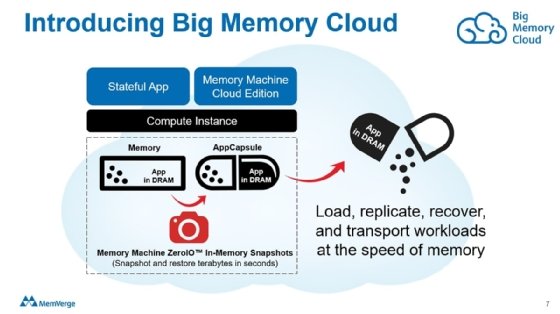
Getty Images/iStockphoto
MemVerge takes Big Memory to the cloud
MemVerge Big Memory Cloud makes stateful applications portable so that they can be moved from on premises to private clouds to public clouds.
MemVerge is taking its flagship memory product, Big Memory Machine, to the cloud, giving users the ability to efficiently move data-intensive applications.
Founded in 2017, MemVerge is an in-memory computing vendor. Its main product is Big Memory Machine, a software layer that enables users to create a shared pool of memory across multiple servers, said Eric Burgener, a senior analyst at IDC. He likened it to how VMware virtualizes compute, networking and storage.
The product uses Intel Optane persistent memory modules -- initially released around the time of MemVerge's founding -- under its covers to provide users with some flexibility to create a pool that might be terabytes of memory, bypassing the normal capacity limitations in traditional RAM, he said.
In the cloud, users can access features that enable them to use temporary instances without losing data and cloud bursting without interruptions. MemVerge's Big Memory achieves this through AppCapsules, a way of containerizing the application through integration with Kubernetes and its existing ZeroIO Snapshots. AppCapsules provide portability from on premises to cloud and between cloud environments.
Big Memory Cloud is interoperable with the major public cloud providers AWS, Microsoft Azure and Google Cloud Platform as it sits on top of the cloud and requires no integration.

It's all about snapshots
Companies are increasingly moving to hybrid and multi-cloud environments, and applications need to be built to take advantage of the cloud's agility, flexibility and scalability, according to Charles Fan, CEO and co-founder of MemVerge.
For some applications, moving from an on-premises to a cloud environment has been seamless. For others, including applications that require a server to retain data and to scale easily -- such as those that perform artificial intelligence or video rendering tasks -- the story has been more complicated.
Data services like snapshots only work on persistent storage, which would be of no use to workloads running in memory, according to Burgener. If there is a process or server failure, recovery is time intensive or users need to start over.
ZeroIO Snapshots use persistent memory as opposed to storage; in other words, zero I/Os are sent to storage. Users can refer to the recent snapshot of memory, potentially saving hours on recovery.
"ZeroIO is a memory snapshot [that] captur[es] a running application state and encapsulates it," Fan said.
These snapshots are placed into AppCapsules, Fan said. From there, they can be loaded, replicated, recovered and transported across clouds.
"To move an application from one cloud to another, like Google to Azure, users have to understand all of the storage pieces related to the application," Burgener said. "AppCapsules make this easier by figuring out the underlying persistent storage needed and moving it all to a new environment."
The technology may sound similar to that of vMotion, a VMware product that enables live migration of running VMs from one server to another. But, Fan clarified, Big Memory Cloud enables users to move a point-in-time snapshot of applications. After the move, a user can use the AppCapsule to restart the application where it stopped before it was migrated.
The advantages of AppCapsules and ZeroIO
Big Memory Cloud's AppCapsules enable customers to take advantage of spot instances. Cloud providers with spare compute instance capacity or spots often provide deep discounts, up to 90%, until they need them back.
The portability of AppCapsules means customers can use spot instances and if the instance is interrupted -- called back by the service provider -- the ZeroIO Snapshot ensures the data is easily recoverable.
Portability also enables applications to use cloud bursting more efficiently, something in-memory apps can't normally do without long service interruptions. As performance needs outgrow the on-premises capabilities, apps extend or "burst" into the public cloud to use its resources, according to MemVerge.
Finally, AppCapsules together with ZeroIO provide added multi-cloud mobility, helping customers work where it makes the most sense while avoiding vendor lock-in, the memory storage vendor stated.
Big Memory Spot Cloud use cases are expected to be available in the next few months, with the cloud mobility and cloud bursting services becoming available next year.
Competition may becoming coming
MemVerge is not alone in its push to help customers move to the cloud, but its approach is unique in the market.
VMware released its software-defined memory tiering, also using Intel Optane persistent memory, in Project Capitola last month, which could go head to head with Big Memory Cloud as they both do tiering, but it is still unclear how it will fit into the cloud storage market. Project Capitola won't be available to customers until next year.
If it does push into the same space as Big Memory Cloud, IDC's Burgener said, the competition might heat up.
"When VMware decides it's important enough for them to get into it, that is a critical inflection point for the technology," he said.




